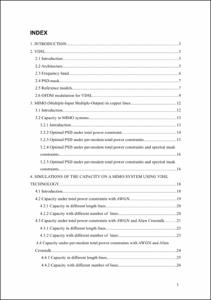Mostra el registre d'ítem simple
Bonded VDSL
| dc.contributor | Moonen, Marc |
| dc.contributor.author | Lizaña Moreno, Josep |
| dc.date.accessioned | 2009-02-18T19:36:50Z |
| dc.date.available | 2009-02-18T19:36:50Z |
| dc.date.issued | 2008-09-15 |
| dc.identifier.uri | http://hdl.handle.net/2099.1/6189 |
| dc.description.abstract | The actual demand of Internet services is increasing fast and the contents are becoming heavier because of the higher demand of video and voice services as VoIP and HDTV. This fact is pushing the actual infrastructure to the limit and service providers are lead to invest in new technologies and new infrastructure. The solution seems to be found in the use of cable and fiber optics but while this technologies are capable of offering video and voice services they cannot offer the 3 services together (voice, video and Internet access). Also the use of this technologies means that the whole actual infrastructure need to be changed. Meanwhile this technologies are not ready, the solution is to improve the performance of the exiting copper pair infrastructure and nowadays the technology that does this better is VDSL which can provide up to 52 Mbps on a single cooper pair loop. Besides, VDSL, as other DSL technologies, is capable of providing Internet and voice services because it is compatible with POTS and ISDN and in addition, VDSL can provide video services thanks to the higher throughput. To achieve this higher bit rates, VDSL uses the frequency range up to 30 MHz and DMT modulations as OFDM that divides the frequency spectrum into a number of tones as FDM but with the particular characteristic that the tones are orthogonal providing a very limited intercarrier interference (ICI) and a better performance. Summed to VDSL, in the last years, the use of multiple transmitters and receivers is revolutionizing telecommunications. MIMO systems has been proved to be a very useful tool to improve capacity in wireless communications by using several antennas at the transmitter and the receiver side but it is also possible to use MIMO in wired communications and in particular in DSL transmissions. For example, using 4 bonded lines it is possible to operate at more than 6 times the rate of a single line. In this paper we will combine the benefits of VDSL and MIMO technologies to implement simulations of the capacity on a system composed of 8 lines transmitting together. The simulations have the purpose of seeing how the capacity of the system is affected by internal and external phenomena as for example different kind of interferences. In the part “Simulations of the capacity” you will find different simulations of a binder of 8 lines using MIMO and VDSL with thermal noise and 3 external noise affecting as well as different power constraints. The external noise here comes from a parallel transmission of another 8-line binder. There is also a simulation of a SISO system with an external noise coming from the parallel lines of the original 8- line binder. We have considered 2 scenarios for the different simulations: the fist one where we evaluate capacity with loops of different lengths and the second one where we evaluate capacity for binders with different number of lines. The different simulations are: – Capacity under total power constraints with Additive White Gaussian Noise (AWGN). – Capacity under total power constraints with AWGN and external noise. – Capacity under per-modem total power constraints with AWGN and external noise. – Capacity under per-modem total power constraints and spectral mask constraints with AWGN and external noise. – Capacity of a SISO system with AWGN and external noise (coming from the parallel lines). After evaluating each simulation separately there is a comparison of all them together where we are able to see their achievements and their behaviors. |
| dc.language.iso | eng |
| dc.publisher | Universitat Politècnica de Catalunya |
| dc.subject | Àrees temàtiques de la UPC::Enginyeria de la telecomunicació::Telemàtica i xarxes d'ordinadors::Xarxes digitals de serveis integrats |
| dc.subject | Àrees temàtiques de la UPC::Enginyeria de la telecomunicació::Radiocomunicació i exploració electromagnètica::Comunicacions mòbils |
| dc.subject.lcsh | Very high-speed digital subscriber lines |
| dc.subject.lcsh | Digital communications |
| dc.title | Bonded VDSL |
| dc.type | Master thesis (pre-Bologna period) |
| dc.subject.lemac | Xarxes Digitals de Serveis Integrats |
| dc.subject.lemac | Comunicacions digitals |
| dc.rights.access | Open Access |
| dc.audience.educationlevel | Estudis de primer/segon cicle |
| dc.audience.mediator | Escola Politècnica Superior de Castelldefels |
| dc.audience.degree | ENGINYERIA TÈCNICA DE TELECOMUNICACIÓ, ESPECIALITAT EN TELEMÀTICA (Pla 2000) |


